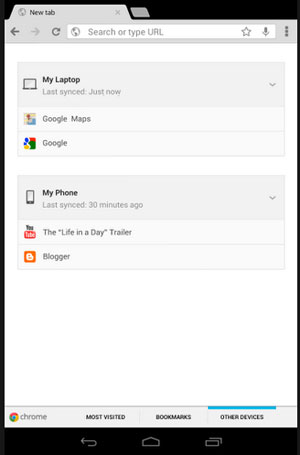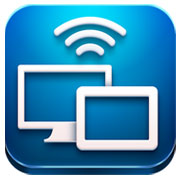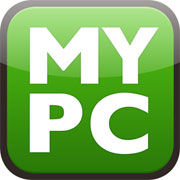
![]()
Chrome for Android, an app from Google, is available for free at Google Play.
Some of my earliest memories of smartphones are of the hassles involved with gettingbookmarks loaded across devices. Why was it that Web properties thought — and some stillthink — you needed different information at your desk from what you wanted on the road?The issue has never been properly addressed — until now, maybe.
Google’s Chrome browser could claim to rectify this perennial problem by syncing viewed pages across devices. I decided to take a good look.
What Is It?
Google’s Chrome browser product promises the holy grail: that you can open up a Webpage on one device, say your desktop, and then move over to your Ice Cream Sandwichor higher-OS Chrome app-installed tablet — and continue looking at the same page.
Does it work? I spent a day with it and the short answer is yes, it does. I was able to readpages alternating between both my PC Chrome browser and my tablet. Goal to Google.
The long answer, however is this: You’ve got to make sure that both devices are set upproperly and that you’re signed-in to both with the same Google ID.
You’ve also got to drill way down into the depths of the respective browser’s settings.Then you’ve got to read help pages that don’t appear to correspond to current versions.
You also have to remember that it’s not only development that’s done by teams who don’tnecessarily talk to each other. So is Help Page writing.
Still, it did work. I could flip from one device to the other.
Comparing It to the Desktop Chrome Browser
Google pitches Chrome as being a browser for your devices that’s just like the one onyour PC. After the relative joy of discovering Web page sync worked, I was disappointedto find that the Chrome Web Store was missing on the Android version.
The Chrome Web Store, for the uninitiated, is a set of plug-ins that Google confusinglycalls “apps.” They include RSS readers and TV feeds among others, and they are neat ways toget content into the browser.
The lack of Chrome Web Store is not the only thing that makes Chromefor Android distinctly unlike the Web browsers on my computer; there’s also itsconspicuous lack of Flash player.
Missing Flash is a reason to consider other Android browsers out there, including Operaand Dolphin products. Although — giving Google the benefit of the doubt — Adobe’s Flashvideo standard is on its way out at the mobile level.
Comparing It to Other Browsers
Speed is another area where Chrome for Android hiccupped. Pitched as abrowser for searching and browsing fast, with accelerated page loading, adjectives like”quick” and “speed” gave me the impression I was in for a Web-based speed record.That was not to be the case. I experienced sticky page scrolling at the image-heavy CNNwebsite compared to scrolling on the stock browser.
A perusal of Google’s Chrome for Android Known Issues Web Page came up withdocumented laggy scroll and zoom issues with heavy and dynamic content.
Not Quite There Yet
I desperately wanted to love Chrome for Android, but it was not to be. The sticky pagescrolling on its own was enough for me to drop it after a day. My instincts tell me that this is simply an immature product, though, with star potential.
Promises from Google that the laggy scrolling on some hardware will be corrected, andthe speedy adjective-laden sales pitches make this app one to watch.



















































